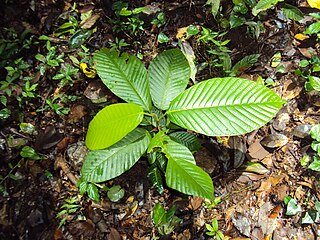
Dipterocarpus retusus, commonly known as hollong, is a large tree and perhaps the best known species in the genus Dipterocarpus. It is native to China, Vietnam, Philippines, Laos, Cambodia, Malaysia, Indonesia, Myanmar, and India. The tree, some 20–30 metres (70–100 ft) tall, is found in Cambodia in dense forests of the plains, common on hillsides and along rivers and in forests between 800 m (2,600 ft) and 1,500 m (5,000 ft) altitude.

Dipterocarpus is a genus of flowering plants and the type genus of family Dipterocarpaceae.
Dipterocarpus coriaceus is a species of tree in the family Dipterocarpaceae endemic to Kalimantan, Sumatra and peninsular Malaysia. This very large tree occurs in mixed dipterocarp forests on hillsides and undulating land. This species was reported in the New Straits Times to be extinct in Peninsular Malaysia in July 2013 as its last natural habitat in Bikam Forest Reserve in Perak was de-gazetted and cleared for oil palm cultivation.
Dipterocarpus costulatus is a species of tree in the family Dipterocarpaceae. It grows up to 50 metres (160 ft) tall.
Dipterocarpus elongatus is a species of tree in the family Dipterocarpaceae found in Indonesia, Malaysia and Singapore. This large tree occurs in secondary and primary forest, as well as in freshwater swamp forest.

Dipterocarpus gracilis is a critically endangered species of tree in the family Dipterocarpaceae, native to South Asia and Southeast Asia.
Dipterocarpus semivestitus is a species of tree in the family Dipterocarpaceae, occurring in Kalimantan and peninsular Malaysia. This tree is almost always found in lowland forest on swampy land. It is very close to extinction.

The horned parakeet is a species of parrot in the genus Eunymphicus, in the family Psittaculidae. It is a medium-sized parrot endemic to New Caledonia. It is called "horned" because it has two black feathers that protrude from the head and have red tips.

Dipterocarpus grandiflorus is a species of flowering plant in the Dipterocarpaceae family. It is an endangered medium hardwood tree of Southeast Asia. It is a large tree which can grow up to 50 metres tall.

The little Japanese horseshoe bat is a species of bat in the family Rhinolophidae. It is found in Japan and possibly China. Its natural habitat is temperate forests. As of 2012, it had not yet been assessed for the IUCN Red List.

Dipterocarpus condorensis is a species of plant in the evergreen or semi-evergreen family Dipterocarpaceae.

Dipterocarpus alatus, also known colloquially as the resin tree, is a tropical forest tree, of dense evergreen or mixed dense forests, in tropical Asia. It is considered vulnerable.
Dipterocarpus fagineus grows as a medium-sized tree up to 45 metres (150 ft) tall, with a trunk diameter of up to 1 metre (3 ft). Bark is greyish brown. The fruits are roundish to ellipsoid, up to 1 cm (0.4 in) long. The specific epithet fagineus is from the Latin meaning "like a beech". Habitat is mixed dipterocarp forest on hills. D. fagineus is found in Sumatra, Peninsular Malaysia and Borneo.
Dipterocarpus kunstleri grows as a canopy tree up to 40 metres (130 ft) tall, with a trunk diameter of up to 1 metre. Bark is orange-brown. Fruit is ellipsoid, up to 5 centimetres (2.0 in) long. Habitat is mixed dipterocarp forest from sea-level to 400 metres (1,300 ft) elevation. D. kunstleri is found in Sumatra, Peninsular Malaysia, Borneo and the Philippines.
Dipterocarpus oblongifolius grows as a tree up to 30 metres (100 ft) tall, with a trunk diameter of up to 1.5 metres. Bark is greyish brown. The fruits are ovoid to spindle-shaped, up to 3 cm (1 in) long. The specific epithet oblongifolius is from the Latin meaning "oblong leaves". Habitat is river banks from sea-level to 400 metres (1,300 ft) elevation. D. oblongifolius is found in Thailand, Peninsular Malaysia and Borneo.
Dipterocarpus rigidus grows as a large tree up to 50 metres (160 ft) tall, with a trunk diameter of up to 1 metre. Bark is rust-brown. The fruits are roundish, up to 5 cm (2 in) in diameter. Habitat is mixed dipterocarp forest on low hills near coasts. D. rigidus is found in Sumatra, Peninsular Malaysia and Borneo.
Dipterocarpus sublamellatus grows as a large tree up to 70 metres (230 ft) tall, with a trunk diameter of up to 3 metres (10 ft). Bark is orange-brown. The fruits are round, up to 3 cm (1 in) in diameter. It is found in a variety of now vulnerable habitats from sea-level to 400 metres (1,300 ft) elevation. D. sublamellatus is native to Sumatra, Peninsular Malaysia and Borneo.

Dipterocarpus hispidus is a species of tree in the family Dipterocarpaceae, endemic to Sri Lanka.
Lipaso Forest Reserve is a protected forest reserve in Telupid District of Sandakan Division, Sabah, Malaysia. It was designated as a Class 1 Protection Forest by the Sabah Forestry Department in 1984. Its area is 3,606 hectares (36.06 km2). The reserve is mountainous with some palm oil plantations and farms in the surroundings. The forest is mostly mixed dipterocarp. Threats to the reserve forests include fires and encroachment for agriculture.









